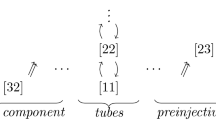Abstract
A group element is called a generalized torsion element if a finite product of its conjugates is equal to the identity. We prove that in a nilpotent or FC-group, the generalized torsion elements are all torsion elements. Moreover, we compute the generalized order of an element in a finite group G using its character table.
Similar content being viewed by others
References
Arad, Z., Stavi, J., Herzog, M.: Powers and products of conjugacy classes in groups. In: Products of Conjugacy Classes in Groups, pp. 6–51. Lecture Notes in Math., 1112. Springer, Berlin (1985)
Bludov, V.V.: An example of an unorderable group with strictly isolated identity. Algebra i Logika 11, 619–632, 736 (1972)
Conway, J.H., Sloane, N.J.A.: Sphere Packings, Lattices and Groups. Third Edition. With additional contributions by E. Bannai, R.E. Borcherds, J. Leech, S.P. Norton, A.M. Odlyzko, R.A. Parker, L. Queen and B.B. Venkov. Grundlehren der mathematischen Wissenschaften, 290. Springer, New York (1999)
The GAP Group. GAP – Groups, Algorithms, and Programming, Version 4.12.2, gap-system.org (2022)
Gorčakov, J.M.: An example of a \(G\)-periodic torsion-free group. Algebra i Logika Sem. 6(3), 5–7 (1967)
Gorjuškin, A.P.: An example of a finitely generated \(G\)-periodic torsion-free group. Sibirsk. Mat. Ž. 14, 204–207, 239 (1973)
Huppert, B.: Endliche Gruppen I. Grundlehren der mathematischen Wissenschaften, vol. 134. Springer, Berlin-New York (1967)
Ito, T.: On a group whose generalized torsion elements are torsion elements. arXiv:2303.05726v2 (2023)
Ito, T., Motegi, K., Teragaito, M.: Generalized torsion and Dehn filling. Topology Appl. 301, Paper No. 107515, 14 pp. (2021)
Ito, T., Motegi, K., Teragaito, M.: Generalized torsion for hyperbolic 3-manifold groups with arbitrary large rank. Bull. London Math. Soc. 55(3), 1203–1209 (2023)
Khukhro, E.I., Mazurov, V.D.: Unsolved problems in group theory. The Kourovka notebook. arXiv:1401.0300v26 (2022)
Liebeck, M.W., Pyber, L.: Upper bounds for the number of conjugacy classes of a finite group. J. Algebra 198(2), 538–562 (1997)
Motegi, K., Teragaito, M.: Generalized torsion elements and bi-orderability of 3-manifold groups. Canad. Math. Bull. 60(4), 830–844 (2017)
Naylor, G., Rolfsen, D.: Generalized torsion in knot groups. Canad. Math. Bull. 59(1), 182–189 (2016)
Osin, D.: Small cancellations over relatively hyperbolic groups and embedding theorems. Ann. of Math. (2) 172(1), 1–39 (2010)
Robinson, D.J.S.: A Course in the Theory of Groups. Second Edition. Graduate Texts in Mathematics, 80. Springer, New York (1996)
Shalev, A.: Word maps, conjugacy classes, and a noncommutative Waring-type theorem. Ann. of Math. (2) 170(3), 1383–1416 (2009)
Vdovin, E.P., Gal’t, A.A.: Strong reality of finite simple groups. Sib. Mat. J. 51(4), 610–615 (2010)
Acknowledgements
We are very grateful to the anonymous referee for the many suggestions which improved the first version of the article. In particular, the current definition of the generalized exponent and the statement of Proposition 2.2(5) were suggested by him or her. We are also grateful to T. Ito for useful discussions regarding this paper. This work was partially supported by CNPq and FAPDF (Brazil). The second author acknowledges the financial support of the CNPq projects Produtividade em Pesquisa (project no.: 308212/2019-3) and Universal (project no.: 421624/2018-3 and 402934/2021-0) and the FAPEMIG Project Universal (project no.: APQ-00971-22). The third author was partially supported by FAPEMIG RED-00133-21.
Author information
Authors and Affiliations
Corresponding author
Additional information
Publisher's Note
Springer Nature remains neutral with regard to jurisdictional claims in published maps and institutional affiliations.
Rights and permissions
Springer Nature or its licensor (e.g. a society or other partner) holds exclusive rights to this article under a publishing agreement with the author(s) or other rightsholder(s); author self-archiving of the accepted manuscript version of this article is solely governed by the terms of such publishing agreement and applicable law.
About this article
Cite this article
Bastos, R., Schneider, C. & Silveira, D. Generalized torsion elements in groups. Arch. Math. 122, 121–131 (2024). https://doi.org/10.1007/s00013-023-01931-5
Received:
Revised:
Accepted:
Published:
Issue Date:
DOI: https://doi.org/10.1007/s00013-023-01931-5



